Shopify SEO: All You Need to Know
Are you looking to improve SEO on your Shopify website and make it rank high on search engines like Google? This Shopify SEO strategy guide is for you.
Let’s face it: ranking your website high on Google is not as easy as it used to be in the early days of the web. Then, all you need to do is stuff your page content with keywords, and everything else falls in place.
Now, you could even get penalized for keyword stuffing. Plus, Google’s ranking metrics have become more complex than ever, so keyword stuffing isn’t helping anymore.
However, the good news is that you can still rank your Shopify website high on Search Engine Result Pages (SERPs).
That is what this Shopify SEO guide is all about: to show you Search Engine Optimization strategies to help you improve your store’s ranking.
What is Shopify SEO?


Simply put, Shopify SEO involves optimizing, well, Shopify for search.
Now, Shopify SEO isn’t so different from the regular search engine optimization you do on WordPress – only that there are only some peculiarities.
For example, to increase the visibility of your store products on Google, you need to take extra care to infuse relevant keywords into your product descriptions and image alt texts.
In addition to that, avoid littering your website with duplicate content. Duplicate content is one problem unique to Shopify, unlike WordPress.
That said, let’s have a look at some of the strategies that you can use to improve your Shopify’s store ranking on Google.
7 Shopify SEO Strategies to Improve Ranking on Google
Here are 7 things you can do to improve Shopify’s store visibility on Google and other search engines.
1. Conduct Keyword Research
The success or failure of your SEO campaign is largely dependent on your choice of keywords. How unfortunate that many eCommerce entrepreneurs don’t give keyword research a moment of their thoughts.
It’s not enough to infuse keywords all over the place on your website. What matters the most is using the right keywords.
How do you find the right mix of keywords for your SEO strategy? Simple. Conduct keyword research.
To start, niche down a bit. Picking a broad niche like “sneakers” won’t cut it. The narrower the niche, the better. Something like CBD for pets can work.
Once you’ve figured out your preferred niche, the next step is to find the right keywords around it.
There are a couple of ways to go about it. One is using Google or Amazon auto-suggest. Finding the keywords your customers are looking for will help them appear in their search results better.
Let’s say you are selling toys for pets. Head over to Google and type in “dog toys”. You will notice that the following keywords will pop up.


If you do the same with Amazon, you will see this:
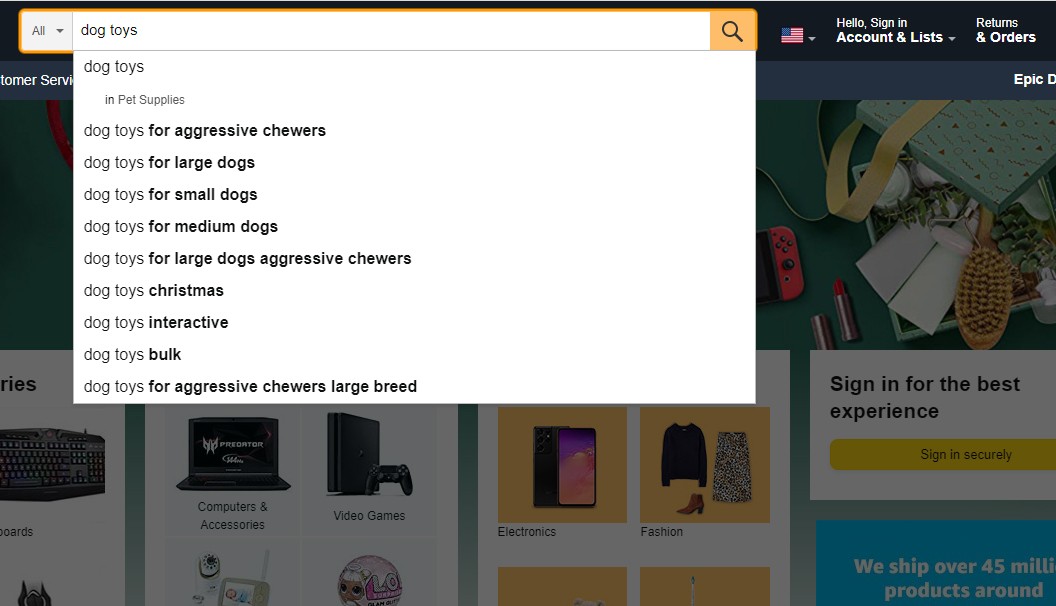

Potential customers will use these search queries to find your store/products. You can stop here or take things further a little bit by using dedicated SEO tools to delve deeper into keyword research.
Let’s now see some of the best keyword tools for Shopify.
Best Keyword Tools for Shopify
Google and Amazon auto-suggest features are great, but they are limited in their scope. For example, they won’t give you insight into the search volume and keyword difficulties of these search queries.
But dedicated keyword tools like Google Keyword Planner and Ahref can. Plus, they can generate an expanded list of related keywords.
For example, if you take one of the suggested keywords – say “dog toys” – and plug it into Google Keyword Planner, you will see this:
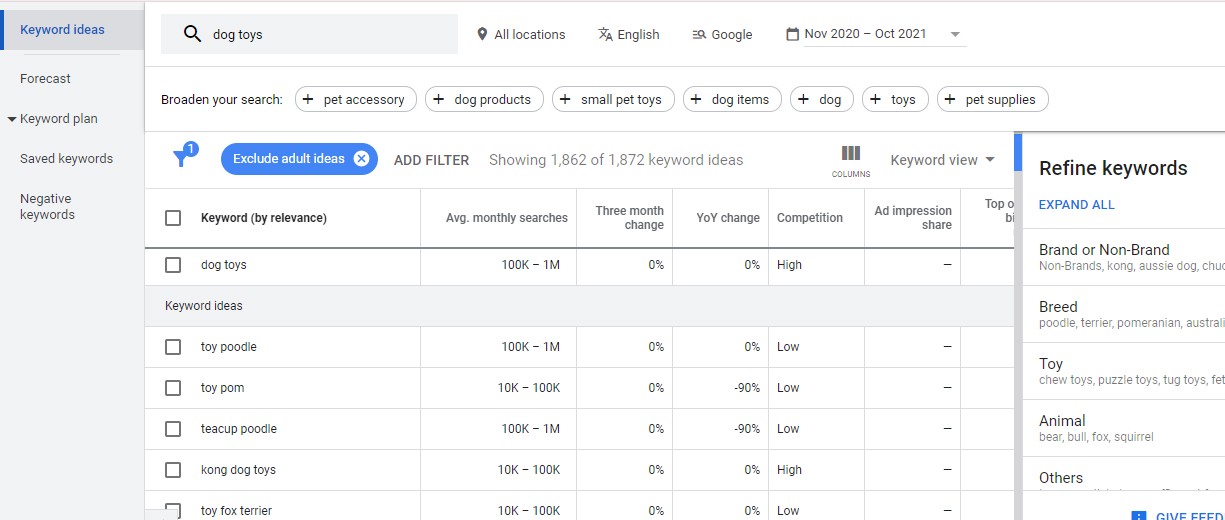

Pay attention to the monthly searches and competition. You will want to go for keywords with high monthly searches and low competition. Besides, SEO extensions for chrome might also effectively aid your SEO efforts.
2. Infuse the Keywords Into Your Page Content
At this point, you should have some keywords you will want to target. The next step is to make it easy for Google crawlers to find your pages using those keywords.
But first, you have to determine the pages you will be adding the keywords to. Your homepage, product pages, and product category pages are the best places to start.
Where precisely on those pages should you add the keywords? Page title, meta description, page body content, and image Alt texts are ideal places.
For instance, let’s say you want to add the keyword “women sweatpant” set to your product page title. I will assume that your website is new and has no product page. This means you will have to add one and infuse your keyword into it.
To do that, log into your Shopify account and click the Pages link like so:


Next, fill out the page title by following this format:
Keyword – Store name
Here’s an example:
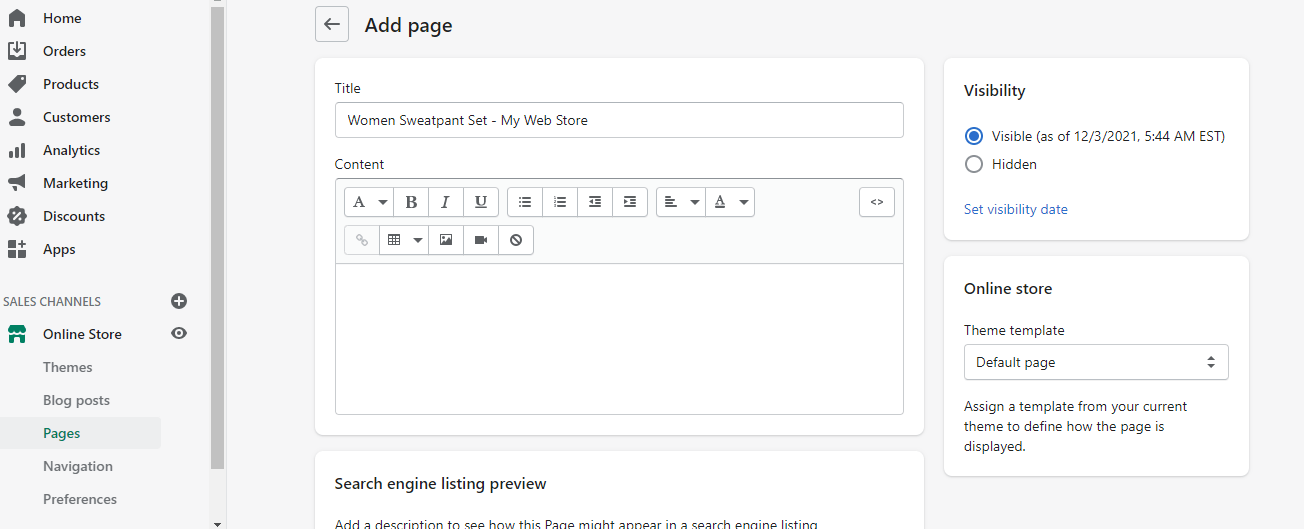

With that, you’ve added a target keyword to your page title. Nice work.
Next is to add keywords to the page description. To do so, click the Edit website SEO link just below, and in the Description box, add descriptive text that best describe your page. Ensure that the description contains your target keywords.
3. Improve Your Website’s Navigation to Improve Shopify SEO
One of the metrics Google checks before ranking a website is how easy it is to navigate. The reason is that websites that are easy to navigate have better user engagement and, hence, lower bounce rates.
That is to say, if your website has a good navigation structure, users will stay longer, and your Shopify store rank will significantly improve.
That is to say, if your website has a good navigation structure, users will stay longer, and your Shopify store rank will greatly improve.
Your homepage is a good place to start optimizing your navigation structure. To begin with, ensure that your product pages can be easily reached from your homepage.
A visitor shouldn’t click more than three times to reach a particular product. Here’s an example of a good structure:
Home >> Product Category >> Product
The next place to optimize is your website menu.
When you add items to your menu, ensure that you use texts that match the title of the page it is pointing to.
For example, if you add “Contact us” to your navigation menu, the page it points to should also have “Contact us” as the title.
In addition to that, when you add links to internal pages in your site, use descriptive anchor texts that match the page they are pointing to.
Take for instance you published a blog post, and in that post, you wish to add a link pointing to one of your products: a black leather bag.
The proper structure for that linking should be:
Check out this black leather bag
And not:
Here is a bag that you might like
To edit your store’s navigation structure, navigate to Online >> Navigation.
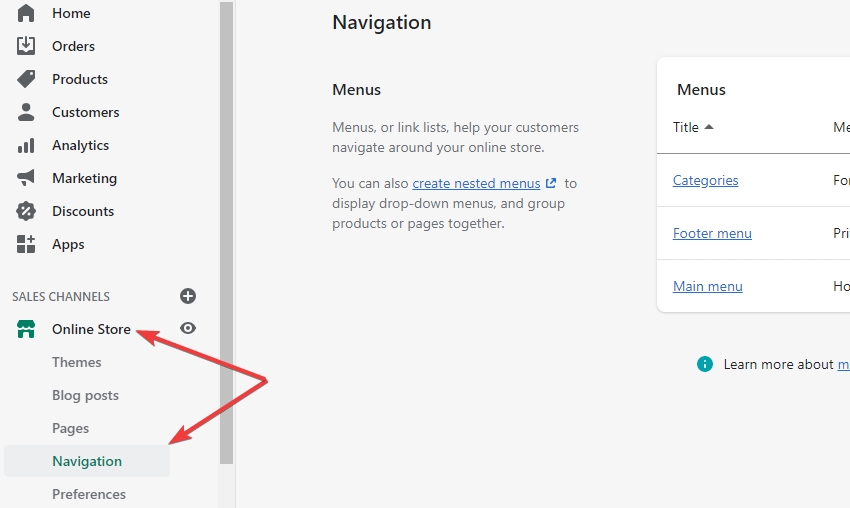

4. Get More Backlinks to Improve SEO
The number and quality of backlinks to your website have an enormous influence on your Shopify SEO.
For this reason, getting as many high-level backlinks is essential to succeed with SEO.
By the way, backlinks are simply links pointing to your website from another website.
Before embarking on a backlink generation campaign, remember that not all backlinks are created the same.
For example, links from Facebook, Twitter, or any other social media platform won’t have any significant impact on your ranking. Also, links from low-quality websites will do your site more harm than good. So, it’s best to avoid them altogether.
But a link from a popular website like CNN will carry a lot of weight, and it’s such a link that you need.
If you are not sure, use this free domain checker tool to determine how valuable a backlink is.
With that said, here are some creative ways you use to generate meaningful backlinks to your store:
- Publish guest posts on high-authority websites. You will naturally earn backlinks when you do so.
- Reach out to bloggers and review websites and ask them to review your products. Most will do so for free.
- Get links from your product manufacturer.
- Post insightful, sharable content to your blog
P.S: As much as you can, avoid buying links. You might end up wrecking your website.
5. Optimize Your Website for Speed
How do you feel when you attempt to open a web page that takes more than 2 seconds to load? Frustrated right? You will likely abandon the website.
That is the same way visitors feel if your website appears to take forever to load. Not only will this lead to an increased bounce rate, but also it will affect your Google search ranking.
Therefore, optimizing your website for speed can boost Shopify SEO.
Here are a few things that you can do to make your website load faster:
- Compress your product images before uploading them
- Use Jpeg images – they are lighter
- Use a light-weight theme. Check out SalesHunterThemes to experience themes with unrivaled page speed.
- Integrate the Accelerated Mobile Pages technology. They make your website load crazy fast
- Reduce the number of apps installed on your website
6. Take Blogging Seriously
To improve your Shopify SEO, you need to regularly publish insightful content on your blog.
Thankfully, Shopify has an out-of-the-box blogging feature. You can access it by navigating to Online Store >> Blog posts
For best results, create content around the keywords that you are targeting.
For example, if you sell women’s sweatpants, blog posts with the following titles could work really well:
- 10 best sweatpant outfit ideas
- How to rock your sweatpants to a party
- 15 things you should know about the female sweatpants
Publishing blog posts that align with your niche makes it easy for Google search crawlers to know what your website is all about.
7. Use the Right Shopify SEO App
If you’ve ever managed a WordPress website before, you sure likely would have heard about Yoast SEO, the most popular SEO plugin for WordPress.
You might begin to wonder if Yoast works on Shopify too. Well, it doesn’t!
But, thankfully, there are lots of other Shopify SEO apps that can help better your Shopify SEO strategy.
Unfortunately, these apps are hardly ever completely free. However, most offer limited free plans. And you will find them on Shopify App Store.
Improve Your Shopify Store Conversion With Adoric
The whole essence of optimizing your Shopify store for search is to attract lots of traffic. However, if you are unable to convert that traffic into sales and subscriptions, what’s the point?
Lucky for you, the Adoric Shopify App can help you convert your website visitors into customers and subscribers.
It does this by allowing you to create enticing and attention-grabbing marketing campaigns in the form of popups, slide-ins, and floating bars.
You are at liberty to build these campaigns from scratch using our design editor, or pick a design from our collection of over 1,000 templates, and then modify it however you please.
On top of that, Adoric comes with an exit-intent technology that helps to reduce cart abandonment on your Shopify store.
Best of all, you can start with Adoric for free. We hope you found this Shopify SEO Guide helpful.
Sign up for a free account today.

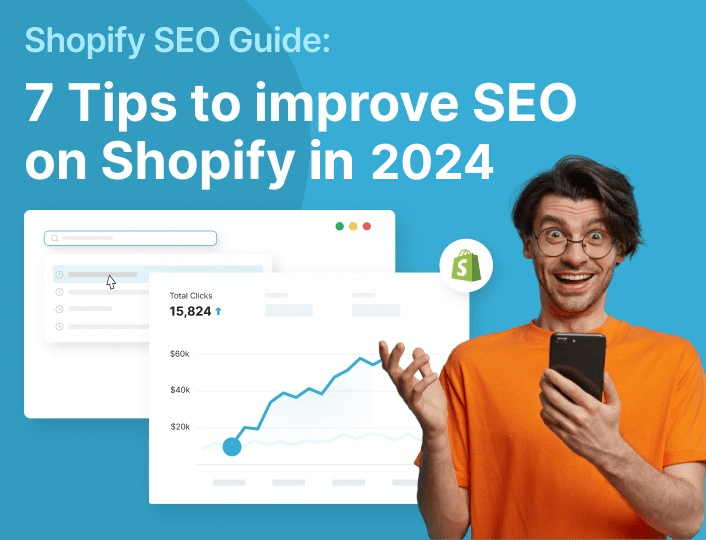


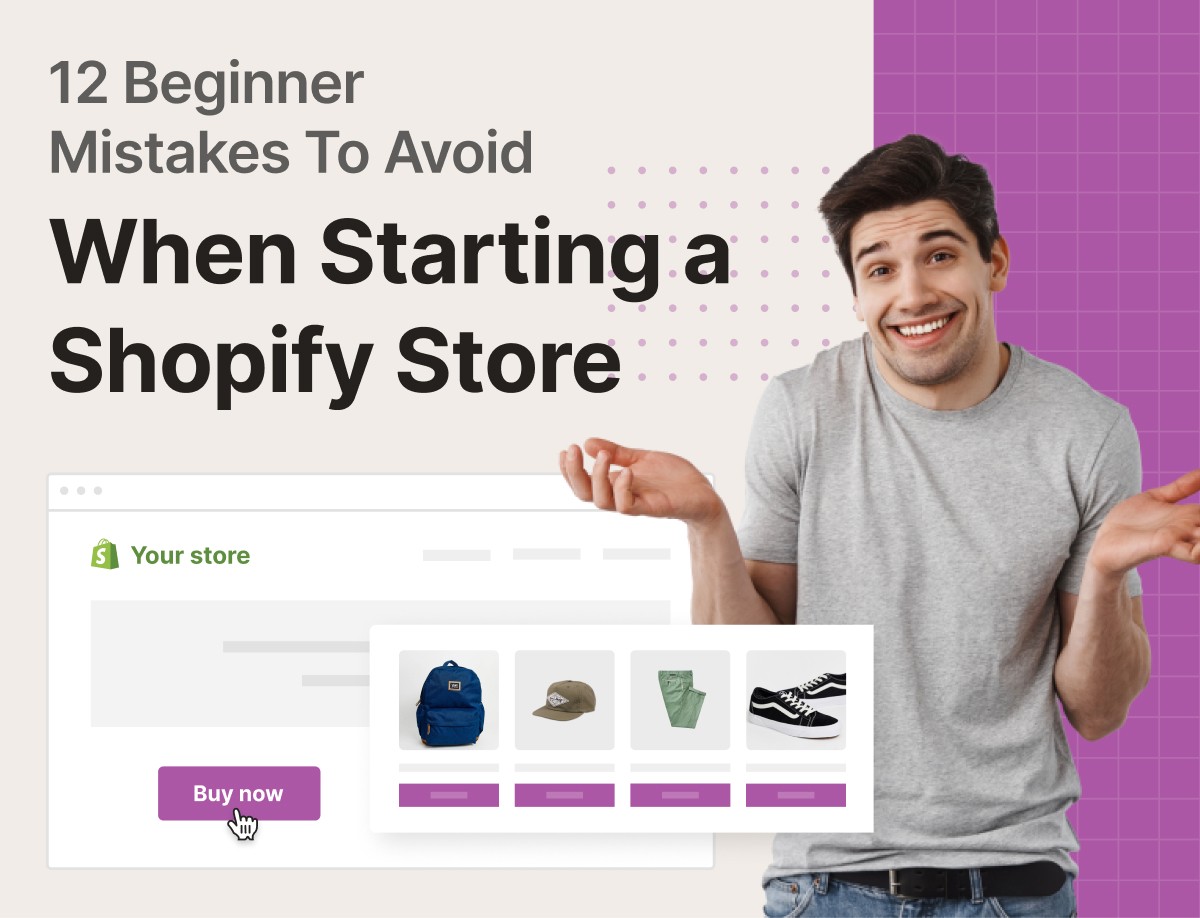
Hi, thanks for your interest. However, we’d have to prevent you from doing that. Thank you.